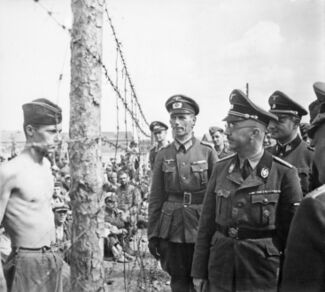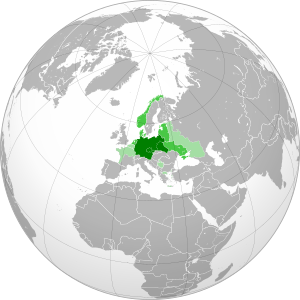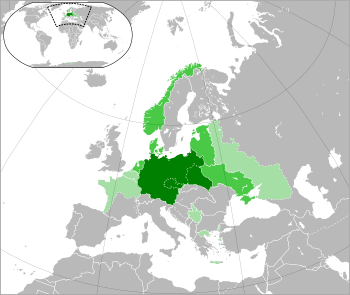أوروپا المحتلة من ألمانيا
German-occupied Europe | |||||||
|---|---|---|---|---|---|---|---|
| 1938–1945 | |||||||
Europe at the height of German expansion in 1942:
| |||||||
| العاصمة | Berlin | ||||||
| اللغات الشائعة | German | ||||||
| صفة المواطن | German | ||||||
| Reich Commissioner | |||||||
• 1938–1945 | Fritz Katzmann | ||||||
| Reichsstatthalter | |||||||
• 1938–1945 | Adolf Eichmann | ||||||
• 1940–1945 | Heinrich Himmler | ||||||
• 1941–1945 | Hermann Göring | ||||||
| الحقبة التاريخية | Interwar period | ||||||
| Area | |||||||
| 1942 | 3،300،000[1] km2 (1،300،000 sq mi) | ||||||
| التعداد | |||||||
• 1942 | 238000000[1] | ||||||
| Currency | Reichsmark (ℛℳ) | ||||||
| |||||||
أوروپا المحتلة من ألمانيا German–occupied Europe أو الامبراطورية النازية تشير إلى البلدان الأوروپية التي كانت محتلة من قوات ألمانيا النازية على فترات مختلفة ما بين 1939 و1945.
بعض البلدان بدأت الحرب كحلفاء للمملكة المتحدة أو الاتحاد السوڤيتي، وأُجبرت على الاستسلام، أو قُمعت ثم أُحتلت. في بعض الحالات، ذهبت الحكومات إلى المنفى، أو تشكلت حكومات في المنفى بواسطة بعض مواطينها، في بلدان الحلفاء الآخرين. احتل النازيون بعض البلدان الأخرى والتي كانت رسمياً على الحياد. بعض البلدان المحتلة كانوا أعضاء سابقين في قوى المحور، واحتلتها القوات الألمانية في مرحلة متأخرة من الحرب.
The German Wehrmacht occupied European territory:
- as far east as the town of Mozdok in the North Caucasus in the Soviet Union (1942–1943)
- as far north as the settlement of Barentsburg in Svalbard in the Kingdom of Norway
- as far south as the island of Gavdos in the Kingdom of Greece
- as far west as the island of Ushant in the French Republic
In 1941, around 280 million people in Europe, more than half the population, were governed by Germany or their allies and puppet states.[2] It comprised an area of 3،300،000 km2 (1،300،000 sq mi).[1]
Outside of Europe, German forces controlled areas of North Africa, including Egypt, Libya, and Tunisia between 1940 and 1945. German military scientists established the Schatzgraber Weather Station as far north as Alexandra Land in Francis Joseph Land. Manned German weather stations also operated in North America included three in Greenland, Holzauge, Bassgeiger, and Edelweiss. German Kriegsmarine ships also operated in all oceans of the world throughout World War II.
التاريخ
Several German-occupied countries initially entered World War II as Allies of the United Kingdom[3] or the Soviet Union.[4] Some were forced to surrender before the outbreak of the war such as Czechoslovakia;[5] others like Poland (invaded on 1 September 1939)[6] were conquered in battle and then occupied. In some cases, the legitimate governments went into exile, in other cases the governments-in-exile were formed by their citizens in other Allied countries.[7] Some countries occupied by Nazi Germany were officially neutral. Others were former members of the Axis powers that were subsequently occupied by German forces, such as Finland and Hungary.[8][9]
معسكرات الاعتقال
| Part of German-occupied Europe | |
|---|---|
 Head of the SS, Heinrich Himmler, inspects captured prisoners in German occupied Minsk, August 1941. | |
| التاريخ | 1941–1945 |
نوع الهجوم | Starvation, death marches, executions, forced labor |
Germany operated thousands of concentration camps in German-occupied Europe. The first camps were established in March 1933 immediately after Adolf Hitler became Chancellor of Germany. Following the 1934 purge of the SA, the concentration camps were run exclusively by the SS via the Concentration Camps Inspectorate and later the SS Main Economic and Administrative Office. Initially, most prisoners were members of the Communist Party of Germany, but as time went on different groups were arrested, including "habitual criminals", "asocials", and Jews.
After the beginning of World War II, people from German-occupied Europe were imprisoned in the concentration camps. About 1.65 million people were registered prisoners in the camps, of whom about a million died during their imprisonment. Most of the fatalities occurred during the second half of World War II, including at least 4.7 million Soviet prisoners who were registered as of January 1945.
Following Allied military victories, the camps were gradually liberated in 1944 and 1945, although hundreds of thousands of prisoners died in the death marches.
After the expansion of Nazi Germany, people from countries occupied by the Wehrmacht were targeted and detained in concentration camps. In Western Europe, arrests focused on resistance fighters and saboteurs, but in Eastern Europe arrests included mass roundups aimed at the implementation of Nazi population policy and the forced recruitment of workers. This led to a predominance of Eastern Europeans, especially Poles, who made up the majority of the population of some camps. The ethnicities of captured people were various other groups from other different nationalities were transferred to Auschwitz or sent to local concentration camps.
البلدان المحتلة
The countries occupied included all, or most, of the following nations or territories:
حكومات في المنفى
حكومات الحلفاء في المنفى
حكومات المحور في المنفى
| Government in exile | Capital in exile | Timeline of exile | Occupier(s) |
|---|---|---|---|
| September 16, 1944 – May 10, 1945 | |||
| 1944 – April 22, 1945 | |||
| March 28/29, 1945 – May 7, 1945 | |||
| 1944–1945 | |||
| Summer of 1944 – May 8, 1945 | |||
| April 4, 1945 – 8 May 1945 | |||
| October 7, 1944 - 8 May 1945 |
حكومات محايدة في المنفى
| Government in exile | Capital in exile | Timeline of exile | Occupier(s) |
|---|---|---|---|
(1923–1938)
|
1919 – present |
| |
(1944 – August 20, 1991) |
June 17, 1940 – August 20, 1991 | ||
(1920–1939)
|
1920 – August 22, 1992 |
|
انظر أيضاً
- Areas annexed by Germany
- Underground media in German-occupied Europe
- Drang nach Osten ("The Drive Eastward")
- Lebensraum ("الفضاء الحي")
- Neuordnung ("الترتيب الجديد")
- أراضي ضمتها ألمانيا النازية
- Pan-Germanism
- الرايخ الألماني الأكبر
- Reorganization of occupied dioceses during World War II
- حائط الأطلسي
- مسرح عمليات أوروپا أثناء الحرب العالمية الثانية
- معسكرات الاعتقال الألمانية النازية
ملاحظات
- ^ Including the Protectorate of Bohemia and Moravia and the General Government
المراجع
- ^ أ ب ت Berend, Iván T. (2016). An Economic History of Twentieth-Century Europe: Economic Regimes from Laissez-Faire to Globalization. Cambridge University Press. p. 72. ISBN 9781107136427.
- ^ "WWII: population of Germany and occupied areas 1941". Statista. Archived from the original on February 7, 2023. Retrieved 11 March 2023.
- ^ Prazmowska, Anita (1995-03-23). Britain and Poland 1939–1943: The Betrayed Ally (in الإنجليزية). Cambridge University Press. ISBN 9780521483858.
- ^ Moorhouse, Roger (2014-10-14). The Devils' Alliance: Hitler's Pact with Stalin, 1939–1941 (in الإنجليزية). Basic Books. ISBN 9780465054923.
- ^ Goldstein, Erik; Lukes, Igor (2012-10-12). The Munich Crisis, 1938: Prelude to World War II (in الإنجليزية). Routledge. ISBN 9781136328329.
- ^ خطأ استشهاد: وسم
<ref>غير صحيح؛ لا نص تم توفيره للمراجع المسماةbritannica - ^ Conway, Martin; Gotovitch, José (2001-08-30). Europe in Exile: European Exile Communities in Britain 1940–45 (in الإنجليزية). Berghahn Books. ISBN 9781782389910.
- ^ Hanson, Victor Davis (2017-10-17). The Second World Wars: How the First Global Conflict Was Fought and Won (in الإنجليزية). Basic Books. ISBN 9780465093199.
- ^ Cornelius, Deborah S. (2011). Hungary in World War II: Caught in the Cauldron (in الإنجليزية). Fordham Univ Press. ISBN 9780823233434.
وصلات خارجية
- Short description is different from Wikidata
- Pages using infobox country with unknown parameters
- Pages using infobox country or infobox former country with the symbol caption or type parameters
- Pages with tracked country data flag variants
- Articles with hatnote templates targeting a nonexistent page
- أراضي محتلة أثناء الحرب العالمية الثانية
- احتلالات عسكرية ألمانية
- Axis powers
- Nazi Germany




